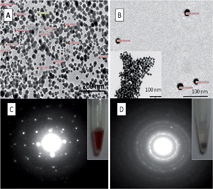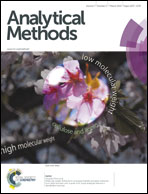Design of screen-printed bulk modified electrodes using anthraquinone–cysteamine functionalized gold nanoparticles and their application to the detection of dissolved oxygen
Abstract
We investigated the electroanalytical determination of dissolved oxygen using low-cost disposable screen-printed bulk modified electrodes based on nanostructures. A nanostructure based on gold nanoparticles functionalized with an anthraquinone derivative and cysteamine was prepared. The nanostructured material was characterized morphologically using transmission electron microscopy and further physical characterization was carried out by energy-dispersive X-ray spectrometry. The prepared material was incorporated into a screen-printable graphite ink to develop the technology for the economic mass production of the next generation of field sensors. The electroanalytical determination of dissolved oxygen was possible in the range 0.2–6.1 mg L−1 with a detection limit of 0.131 mg L−1 (based on 3σ). We demonstrate proof-of-concept that this approach provides a rapid and inexpensive sensing strategy for the determination of dissolved oxygen in contaminated water samples.


 Please wait while we load your content...
Please wait while we load your content...